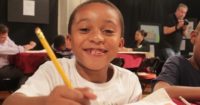by Thurman E. Scott
We opened our doors to the youth of our city and their critical need for creative guidance and outlet for expression. We started The Young Peoples Creative Workshop which is a free class in creative development for children. In one year’s time, The Young Peoples Creative Workshop has developed serious and disciplined young artists who come to their theatre to tell their stories in voice, movement and writing. Their talents are boundless, their expressions are illuminating and their commitment to their own development is inspiring.
In founding the Young Peoples Creative Workshop, I have invested my many years of creative growth, experience and accomplishment to establish an environment where expansion of the child’s creative expression can take place. I make a strong initial contact with each child. Each child is to know that he or she is accepted by me, the staff and the other children. Once this acceptance is established, we work through a series of exercises.
First we ask each child to speak about their week. We ask each child to tell what happened to them this week and what they did. This helps them to feel accepted in a group. It gives them the experience of adults listening to them. It allows a child to relax.
Then we work on an imagination exercise. This opens the child to powers and gifts inside them they often have no idea exist. Once we recognize that the possibility of such powers and gifts exist, each child soon after assumes the probability that there are gifts inside them. Powerful images and thoughts begin to emerge from the children effortlessly, with the ease of play. These expressions reveal the uniqueness in each of the children. When a child’s expression of his or her uniqueness is upheld, valued and even celebrated in the world, as it is with consistency in the Young Peoples Creative Workshop, the child feels power and importance. He or she learns to say, I have something good.
With this feeling of validation the child is willing to have the discipline to listen and to learn because this young individual has been accepted and respected. Now a relationship of respect can grow between student and teacher. The student knows he or she has something to be nurtured. The teacher feels validated by seeing growth take place in the students. Creative exchange, responsibility and discipline take place.
Movement work is then introduced, which gets the body in tune with the imagination. These exercises are stimulating emotionally, intellectually, imaginatively and physically, meaning the physical limitations of armor that hold back expression start to drop away. We spend a number of weeks with imagination and movement work.
Then we express that free, spontaneous, imaginative energy in text work. The children work on contemporary and classical material. They also create their own original monologues through our original writing technique. This is a technique which I began formulating several years ago by applying the creative principles of my acting technique to the written word. I taught some of the steps of the writing technique during our International Youth Day and the young people from all over the world wrote expressions to one another and found connections between themselves that broke down barriers of race, class and nationality.
I have found the process of teaching children is no different from the process of teaching adults. It is very exciting to teach children creative process because children are much more available to their instinctive responses than adults. A child’s natural instinct is to have a positive energy about life. They have not had the years of suppression and armoring which makes adults hold back in their creative expression. The children teach me. I open myself to be led by the children.
Over the years I have created many acting, writing and creative development exercises. Some of them are extremely sophisticated and I have found them to be difficult for some adults. However, for children, not only are these exercises easy to do, but the children often add whole new dimensions to these creative forms and structures. I feel blessed to be able to create together with these open and vulnerable beings. Often such young minds are capable of truly revolutionary creative insights.
With this understanding I look forward to continuing my work with young minds. Young minds are uniquely able to remain curious. We must keep an open and continuous dialogue between the young minds and those of longer experience in order to keep curiosity alive in the seniors among us. Curiosity is the power in all creative process. Without curiosity we are condemned to repetition. Only curiosity meets the unknown with hopeful expectation. From such hopeful expectation we can rebuild old, accepted, traditional forms and conceive of worlds with powerful new possibilities.

